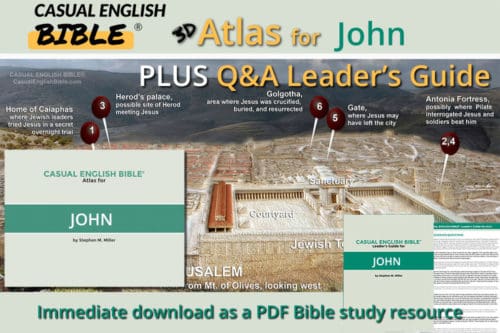Description
Preview
What you get in the Lamentations Bible Atlas:
- Atlas of 15 high resolution maps about Joshua
- 22 PDF pages of resources
Lamentations is the kind of letter a Jew might have written from a German concentration camp during the Holocaust.
It’s that painful.
We might think of the Holocaust of the 1940s as the worst event in Jewish history. But there’s a 2,600-year-old event that rivals it.
In 586 BC, Babylonian invaders from what is now southern Iraq erased the Jewish nation from the world map.
Jews who survived the battles suddenly became a people without a country and without a God, it seemed to some.
After all, they lost their only place to worship and offer sacrifices. Jerusalem’s magnificent Temple, built 600 years earlier by King Solomon, was demolished.
To make sure Jews didn’t resurrect their ghost towns and dead nation, Babylonians exiled leading citizens to Iraq, where they could keep an eye on them.
Babylonian soldiers leveled Jerusalem, along with many cities in Judah. They stripped Jerusalem’s Temple of its valuables—perhaps even the famous Ark of the Covenant, a gold-covered chest that held the 10 Commandments.
Horrors of exile
Lamentations tells the horrific story of what Jews suffered in exile. During Babylon’s siege of Jerusalem, Jews inside the city ran out of food.
“Tenderhearted women boil their children—
Fresh meat for the starving
In a war that ended my nation” (Lamentations 4:10).
The writer confesses sins of the nation and asks God to restore his relationship with the people. But the writer doesn’t seem hopeful God will do it.
He may fear that since the nation broke their agreement with God, an agreement inherited from the times of Abraham and Moses, that God is moving on without them.
The writer closes the letter with a pitiful question to God—one that could easily have been asked from a Nazi concentration camp:
“Are we dead to you?” (Lamentations 5:22).
A, B, C’s of the Jewish pain
Whoever wrote Lamentations came up with a creative way of saying, “We’ve suffered everything from A to Z.”
There are 22 letters in the ancient Hebrew alphabet. There are also 22 verses in every Lamentations chapter except one. Chapter 3 has three sets of 22 verses; 66 verses in all.
Each verse in Lamentations starts with a letter of the alphabet, working from first to last. Verse one begins with the first Hebrew letter, aleph. Verse two begins with the second Hebrew letter, beth, and verse three begins with the third letter, gimel. This continues through 22 verses.
If we did that in English, the A, B, C verses might read something like this.
- A disgrace has consumed our nation.
- Because of what we’ve done, we’ve lost our land, our freedom, and our Temple.
- Children who are precious as gold to us are treated like clay pots.
The songwriter who wrote Psalm 119 did the same thing, as a way of expressing his love for Jewish laws and tradition.
These two writers never bothered to explain why they went to all that trouble. But in the case of Lamentations, it seems apparent that the writer was trying to say the Jewish exiles suffered everything we could imagine, from A-Z many times over.
In addition to the Lamentations Bible Atlas
You might consider the atlas for Isaiah
Best resource for comparing other Bible translations: Bible Gateway. This isn’t an ad. It’s a recommendation from the Casual English Bible.
To support the work of paraphrasing the Casual English Bible and keeping it free online:






